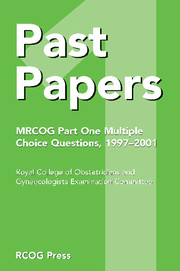Book contents
- Frontmatter
- Contents
- Introduction
- March 1997 – Paper 1
- March 1997 – Paper 2
- September 1997 – Paper 1
- September 1997 – Paper 2
- March 1998 – Paper 1
- March 1998 – Paper 2
- September 1998 – Paper 1
- September 1998 – Paper 2
- March 1999 – Paper 1
- March 1999 – Paper 2
- September 1999 – Paper 1
- September 1999 – Paper 2
- March 2000 – Paper 1
- March 2000 – Paper 2
- September 2000 – Paper 1
- September 2000 – Paper 2
- March 2001 – Paper 1
- March 2001 – Paper 2
- September 2001 – Paper 1
- September 2001 – Paper 2
- Index
March 2001 – Paper 2
Published online by Cambridge University Press: 05 July 2014
- Frontmatter
- Contents
- Introduction
- March 1997 – Paper 1
- March 1997 – Paper 2
- September 1997 – Paper 1
- September 1997 – Paper 2
- March 1998 – Paper 1
- March 1998 – Paper 2
- September 1998 – Paper 1
- September 1998 – Paper 2
- March 1999 – Paper 1
- March 1999 – Paper 2
- September 1999 – Paper 1
- September 1999 – Paper 2
- March 2000 – Paper 1
- March 2000 – Paper 2
- September 2000 – Paper 1
- September 2000 – Paper 2
- March 2001 – Paper 1
- March 2001 – Paper 2
- September 2001 – Paper 1
- September 2001 – Paper 2
- Index
Summary
1. Uric acid
A. is formed from the breakdown of purines.
B. serum concentrations are raised during normal pregnancy.
C. serum concentrations are increased during thiazide diuretic therapy.
D. is reabsorbed in the proximal renal tubule.
E. is excreted unchanged in the urine.
2. The level of serum uric acid characteristically
A. falls with starvation.
B. is higher in men than women.
C. rises on taking corticosteroid therapy.
D. falls on treatment with 5 g of aspirin daily.
E. increases in acute leukaemia.
3. Renal sodium retention is favoured by
A. a high glomerular filtration rate.
B. increased secretion of renin.
C. haemoconcentration.
D. expansion of plasma volume.
E. a low renal blood flow.
4. Deficiency of the following substances and diseases are correctly matched:
A. thiamine: pellagra.
B. cyanocobalamin : microcytic anaemia.
C. niacin: beriberi.
D. folates: sprue.
E. ascorbic acid: night blindness.
5. Fetal pulmonary surfactant
A. contains less than 10% lipid.
B. can be detected in amniotic fluid.
C. contains phosphatidylglycerol.
D. is predominantly dipalmitol-phosphatidylcholine.
E. is more than 40% albumin.
6. Potassium
A. is mainly intracellular.
B. plasma levels vary in proportion to intracellular levels.
C. plasma levels are decreased in Addison's disease.
D. plasma levels are increased in diabetic ketoacidosis.
E. deficiency occurs with prolonged vomiting.
- Type
- Chapter
- Information
- Past Papers MRCOG Part One Multiple Choice Questions1997–2001, pp. 172 - 181Publisher: Cambridge University PressPrint publication year: 2004



